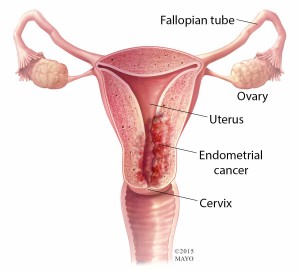-
Mayo Clinic Q and A: Tests may be needed to determine cause of abnormal bleeding
DEAR MAYO CLINIC: I am 40 years old. After having a period that lasted nearly two months, I had tests done that showed a small, hyperechoic lesion within the endometrium. What exactly does this mean? My primary care doctor suggested a hysterectomy as treatment. Are there other ways to treat this condition?
ANSWER: Thank you very much for your important question. This can be a source of much confusion and concern, so I hope I can help you with that.
The endometrium is the layer of cells that make up the lining of your uterus. It is not uncommon for small lesions to form within that lining. When that happens, the lesion may trigger abnormal uterine bleeding similar to the kind you are experiencing. In some cases, lesions in the endometrium can signal a larger problem, such as cancer. But in many situations, they are not cancerous and pose no serious health risks.
The term “hyperechoic” is used to describe how the tissue looks during an ultrasound exam. This is a rather nonspecific term meaning that during the test the tissue reflected back an unusually large number of ultrasound echoes.
Although an ultrasound is an important tool for evaluating abnormal uterine bleeding, it cannot always provide all the information needed to diagnose the underlying cause or determine the best treatment. That seems to be the case here. To find out more, and to help you decide what, if any, treatment is required, you may need additional testing.
Further evaluation could be done using either a sonohysterogram or a hysteroscopy. A sonohysterogram is an enhanced type of ultrasound. During this test, fluid is injected through a tube into your uterus via your vagina and cervix. After the fluid is in place, a doctor uses ultrasound to look for problems in the lining of the uterus. The fluid makes it easier for the doctor to see abnormalities in the endometrium.
During a hysteroscopy, a small, lighted telescope, called a hysteroscope, is inserted through your cervix into your uterus. Your doctor then expands the uterine cavity by injecting it with saline and examines the walls of your uterus.
If these tests confirm that you have a lesion in your uterus, then your doctor may recommend removal of the lesion. After it has been removed, the lesion could be tested for signs of cancer. In many cases, removing a lesion can be done with a minimally invasive surgical procedure. That procedure often can be completed during an office visit and does not require a hospital stay.
If the additional tests show that there is not an endometrial lesion, then talk with your doctor about other likely causes for your abnormal bleeding, along with possible treatment options. Although heavier menstrual bleeding is common in women your age, bleeding that lasts for months is not normal and should be assessed.
From your description, I would not recommend that you get a hysterectomy at this time. Both conditions — the abnormal uterine bleeding and the endometrial lesion — should be evaluated further as I have discussed. There are several treatment options for abnormal uterine bleeding, and endometrial lesions often can be removed safely and effectively without taking out the entire uterus.
As you move forward with more tests and evaluation, consider seeking specialty care by consulting a physician who focuses on gynecology or women’s health. — Matthew Hopkins, M.D., Obstetrics and Gynecology, Mayo Clinic, Rochester, Minn.







